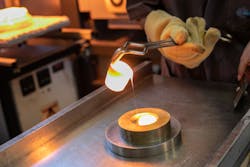Niobium oxide plays a ‘network former’ role within silicate glass structures
Behind the transparent façade of glass lies a realm of intricate molecular structures and unique properties. As we navigate a world increasingly reliant upon specialized optical glasses, the quest to understand the nuances of glass composition and its effects on functionality is increasingly essential.
So a team of researchers from the Federal University of São Carlos (UFSCar) and the University of São Paulo (USP) in Brazil are delving deep into the realm of glass intermediate oxides, which are known for possessing unique optical properties within silicate glasses (see video).
Today, materials scientists rely on machine-learning software and other computational resources to design glass with customized properties, but doing so requires reliable databases and structural parameters that take into account the physiochemical complexities of glass.
Glass that contains niobium is known for its outstanding nonlinear optical properties, but until now the structural role of niobium was somewhat obscure because of a lack of systematic spectroscopy characterization data.
Working at the universities’ joint Center for Technology, and Education in Vitreous Materials (CeRTEV), Henrik Bradtmüller, a postdoctoral researcher working with his advisors Edgar Dutra Zanotto (UFSCar) and Hellmut Eckert (USP), respectively director and vice-director of CeRTEV, set out to fill this knowledge gap by focusing on the captivating interplay between the composition of glasses and how it affects their structure and functionality.
Within the realm of oxide glasses, three main types of ingredients exist: network formers, network modifiers, and intermediate oxides.
“Network formers like silicon dioxide (SiO2) create the three-dimensional (3D) structure of glass, while network modifiers break up these bonds and influence properties,” explains Bradtmüller. “Intermediate oxides, the focus of our study, can act in complex ways depending on the composition of the glass.”
What role does niobium oxide play within silicate glasses?
The team’s study explored the role of niobium oxide (Nb2O5) within silicate glasses. “While Nb2O5 is primarily used to enhance the refractive indices of glasses for optical applications, its precise role within the glass structure has remained elusive,” Bradtmüller says.
This is where combining two types of spectroscopy came in handy: Raman spectroscopy and nuclear magnetic resonance spectroscopy (NMR), which both provide precise, and often complementary, information about the molecular structure of materials on different length scales.
By focusing on different glass compositions using Raman and NMR spectroscopy, the team made a twofold discovery: First, adding Nb2O5 to lithium silicate glasses led to a strengthening of the SiO2 network, which increases thermal stability. Second, they identified the formation of niobium-oxide clusters within glasses with higher niobium concentrations—with heightened electronic polarizability, which has a significant impact on the optical properties of the glass.
These discoveries shed light on the role of Nb2O5 as a network former, which is important for designing stable optical glasses—and it’s important to note this is the first time this structural arrangement has been reported.
Another surprising aspect of their research was being able to apply a cutting-edge NMR method called “W-RESPDOR,” which Bradtmüller and Eckert developed in 2020 with researchers from the University of Münster in Germany, to glasses for the first time.1 “This technique allows us to directly measure distances between atomic species that were previously out of reach for NMR and to pinpoint the formation of niobium clusters,” Bradtmüller says. “It felt like a breakthrough because it provided clarity about a topic that’s puzzled researchers for a long time.”
And it demonstrated their approach based on combining the two types of spectroscopy with computational modeling can be used to study functional elements of many other types of glass—including optical materials, bioactive glass, and glassy fast-ion conductors. It will also enable the development of innovative glass formulations adapted for various applications.
The researchers’ insights may “pave the way for the development of transparent glass-ceramics featuring nanocrystalline lithium niobate,” says Bradtmüller. “These nanocrystalline phases, although difficult to detect using conventional x-ray scattering methods, can now be quantified thanks to our novel NMR approach.”
In the future, Bradtmüller and colleagues plan to explore the effects of other NMR-active intermediate oxides, starting with lanthanum oxide, which is also widely used in optical glasses to enhance refractive indices.
REFERENCE
1. A.-L. Wübker et al., Chem. Eur. J., 27, 52, 13249–13257 (Sep. 15, 2021); https://doi.org/10.1002/chem.202102113.
FURTHER READING
H. Bradtmüller, Q. Zheng, A. Gaddam, H. Eckert, and E. D. Zanotto, Acta Mater., 255, 119061 (Aug. 15, 2023); https://doi.org/10.1016/j.actamat.2023.119061.
About the Author
Sally Cole Johnson
Editor in Chief
Sally Cole Johnson, Laser Focus World’s editor in chief, is a science and technology journalist who specializes in physics and semiconductors.

